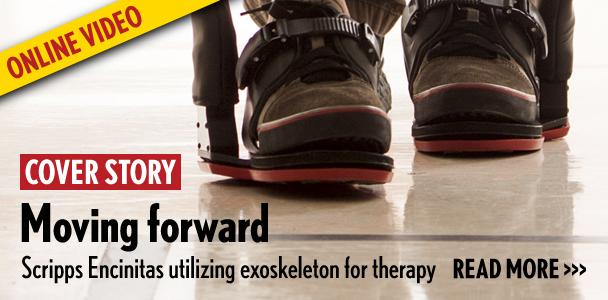Hermes Castro used to consider riding his bike 20 miles to work as part of his regimen as a triathlete and physical trainer. But on Sept. 1, 2006, his life changed as he was riding his yellow racing bike and got hit head-on by a drunken driver. In addition to multiple injuries, he suffered lower-extremity paralysis.
But today, at Scripps Encinitas Rehabilitation Center, Castro is one of the first people in the area to use a robotic exoskeleton that is retraining his body to walk.
Dr. Michael Lobatz is the medical director of the rehabilitation center.
“Using robotics and rehabilitation care is excellent in terms of improving outcome for patients; it allows the patient to do repetitive kinds of activities with their arms and/or legs and get them up and moving,” Lobatz said.
Castro smiled in anticipation of his workout as physical therapists strapped the Ekso Bionics device on his body. After he stood up to his 5-foot-10-inch height, he was ready to go. One therapist monitored a small machine on his back to ensure proper balance while another therapist walked by his side.
The machine lifts his legs for him. Still, Castro has to make sure that he stays balanced.
He appeared to be moving forward in other ways. Where he originally used a walker for support, Castro now used poles.
He lifted one foot, then the other, as he made his way up and down the aisle. Previously, he was impatient.
“I actually wanted to speed up the process and take faster steps; they kept warning me not to, but to just take my time,” he said.
Castro said he knows his lower body is getting a good workout because when he’s done, his legs are sweating. And it feels great to rest when he’s done.
“It provides strength to their bones by putting weight on their bones; it also provides better circulation since they’re moving their legs and standing up versus just sitting in a chair,” Lobatz explained.
The increased blood circulation improves all body functions and helps provide mental clarity. With a huge amount of repetition, the muscles send signals to the brain, reteaching the body how to walk in a natural gait.
“It’s like learning to write with my left hand,” Castro said
But Castro was upbeat and even philosophical about his accident. That’s partially because everyone in his family has faced mishaps – his brother was airlifted the year before Castro’s accident; his sister has been through two windshields; his mother has a titanium support in her ankle from a mountain biking accident; and his father has too many mishaps to count.
“But mine is definitely the worst,” he said.
Still, he said he believes this is the risk that comes with an active lifestyle. And he remains optimistic because he sees learning to walk again as just another challenge.
“When you talk to an individual who’s been in a chair for many years and now they can stand and take steps and look someone in the eye, the mental health aspects of this are enormous, as well,” Lobatz said.
Castro said it feels great to be on his feet.
“It’s like I never stopped walking,” he said.
Helen Hawes is a North County freelance writer



